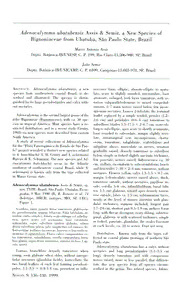
Adenocalymma ubatubensis Assis & Semir, a new species of Bignoniaceae from Ubatuba, São Paulo State, Brazil PDF
Preview Adenocalymma ubatubensis Assis & Semir, a new species of Bignoniaceae from Ubatuba, São Paulo State, Brazil
Adenocalymma ubatubensis Assis & Semir, a New Species of Bignoniaceae from Ubatuba, Sao Paulo State, Brazil Marco Antonio Assis Depto. Botanica-IB/UNESP, C. P. 199, Rio Claro-13.506-900, SP, Brazil Joao Semir Depto. Botanica-IB/UNICAMP, C. P 6109, Campinas-13.083-970, SP, Brazil ABSTRACT. Adenocalymma ubatubensis, a new rescence base, elliptic, obovate-elliptic to spatu- species from southeastern coastal Brazil, is de¬ late, acute to slightly rounded, mucronulate, base scribed and illustrated. The species is distin¬ attenuate, enlarged, both faces tomentose, with ve¬ guished by its large pseudostipules and calyx with¬ nation subparallelodromous to mixed craspedod- out nectaries. romous, 5-7 main nerves raised below, few incon¬ spicuous nectaries. Leaves 2-foliolate, the terminal Adenocalymma is the second largest genus of the leaflet replaced by a simple tendril; petioles (1.2— tribe Bignonieae (Bignoniaceae), with ca. 50 spe¬ 2.6 cm) and petiolules (0.6-4 cm) tomentose to cies in tropical America. Most species have a re¬ subvillose; blades 5.5—17.5 X 2-6.7 cm, ovate-ob¬ stricted distribution, and in a recent study (Gentry, long to subelliptic, apex acute to shortly acuminate, 1993) six new species were described from eastern base rounded to subcordate, margin slightly revo¬ South America. lute, intramarginal vein inconspicuous, charta- A study of recent collections of Adenocalymma ceous, tomentose, subglabrate, scabridulous and for the “Flora Fanerogamica do Estado de Sao Pau¬ subpilose above, muriculate on nerves, venation lo" project revealed a distinct new species related gradually raised, densely tomentose to subvillose to A. hatschbachii A. H. Gentry and A. ackermanii below, simple or forked slightly uncinate trichomes, Bureau & K. Schumann. The new species and Ad¬ few punctate, nerves raised. Inflorescence ca. 10 enocalymma hatschbachii occur in the Atlantic cm, axillary, racemiform to subcorymbiform; bracts rainforest of southeastern coastal Brazil, while A. and bracteoles 7—10 X 2—1 mm, tomentose, without ackermanii is known oidy from the type collected nectaries. Flowers yellow, calyx 1.3—1.5 X 0.7 cm, in Minas Gerais state. margin 5-denticulate, nerves raised above, thick, tomentose outside, without nectaries, papillose in¬ Adenocalymma ubatubensis Assis & Semir, sp. side; corolla 5—6 cm, infundibuliform, basal tube nov. TYPE: Brazil. Sao Paulo: Ubatuba, Picin- (ca. 1.5 cm) glabrous, toward apex densely tomen¬ guaba, 9 May 1990 (fl), R. Romero et al. 74 tose outside, lobes ca. 1.5 cm, subtomentose faces, (holotype, HRCB: isotypes, MO, SP, UEC). inside at the level of stamen insertion with glan¬ Figure 1. dular trichomes; stamens included, longest pair Scandens, ramis junioris dense tomentosis, glabrescen- 1.7-2.6 cm, shortest pair 0.5-1.9 cm, anthers 4 mm tis. pseudostipulae magnae foliaceae. Folia bifoliolata, in- long, with thecae divergent; ovary oblong, subtetra- terdum cirrho simpliei, foliola ovato-oblonga vel subellip- gonal, glabrous or with scattered trichomes, simple tica. apice acuto vel acuminato, base rotundata, or forked, punctate, glandular; the ovules biseriate subeordata, supra subvillosa tandem glabrata, subtus densa subvillosa. pilosa, pi 1 is, simplicibus vel ramosis. ln- in each locule, ca. 18 to series. Fruit not seen. florescentiae axillares racemosae, braeteis et bracteolis to¬ mentosis et eglandulosis. Flores calyce campanulatos ex- Distribution. Known only from the types col¬ tus tomentosos, eglandulosos, corolla campanulata, lutea, lected in coastal plains (restinga) of northern Sao basi glabra, supra dense tomentosa, stamina inclusa. Cap- Paulo state. sula ignota. Adenocalymma ubatubensis has a calyx without Lianas, branchlets densely tomentose when nectaries and long pseudostipules (1.1-3.5 cm young, soon glabrate when older, without interpe- long), densely tomentose and with conspicuous tiolar nectaries (glandular fields), lenticellate; the nerves raised, more or less parallel, that differen¬ two basal leaflets of each leaf forming pseudosti¬ tiate this new species from all species circum¬ pules, 1.1—3.5 X 0.4—1.4 cm, persistent in inflo¬ scribed in the genus. Two related species, Adeno- Novon 9: 136-138. 1999. Volume 9, Number 2 Assis & Semir 137 1999 Adenocalymma ubatubensis from Brazil Figure I. Adenocalymma ubatubensis Assis & Semir. —A. Flowering branch. —B. Pseudostipule. —C. Bud showing calyx and bracteoles without nectaries. —1). Ovary and disc. —F. Ovary cross section. (R. Romero el al. 74.) calymma ackermanii and A. hatschbachii, also have mentose pseudostipules (Gentry, 1993). Moreover, eglandular calyxes. Adenocalymma hatschbachii, A. hatschbachii has membranaceous and only pu- which also occurs in the Atlantic rainforest, differs berulous, long-acuminate leaflets, with stamens in having smaller (5 mm), subulate, and non-to- more or less exserted. The other species, Adeno- 138 Novon calymma ackermanii, has a similar form of pseu¬ Acknowledgments. We thank Antonio Furlan, dostipules, hut these are more acute and puberu- Reinaldo Monteiro, and Angela B. Martins for com¬ lous (Bureau & Schumann, 1896-1897). It also ments on earlier drafts, and Lindolpho Capellari, differs in the smaller leaflets and in the fewer num¬ Jr., for preparing the line drawings. We also ac¬ ber of ovules in the loeule (only 26). knowledge financial assistance from grants from Another species with conspicuous pseudostip¬ Fundunesp and FAPESP. ules is Adenocalymma prancei A. H. Gentry. How¬ Literature Cited ever, the pseudostipules of that species are linear- Bureau, E. & K. Schumann. 1896-1897. Bignoniaceae. oblong and measure up to 1.3 cm long (Gentry, In: C. F. P. Martius. Flora Brasiliensis 8(2): 1 —4-S2. 1978). It also differs in having a glandular calyx Monachii. and in occurring in central and upper Amazonia. Gentry. A. H. 1978. Studies in Bignoniaceae 31: New spe¬ cies and combinations from Amazonian Peru and Brazil. Ann. Missouri Bot. Card. 65: 725-735. Para type. BRAZIL. Sao Paulo: Ubatuba, Picingua- -. 1993. Six new species of Adenocalymma (Bignoni¬ ba, 6 May 1988 (fl), R. Costa et al. 14 (HRCB, UEC). aceae) from eastern South America. Novon 3: 137-141.
